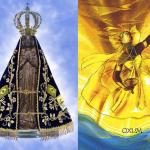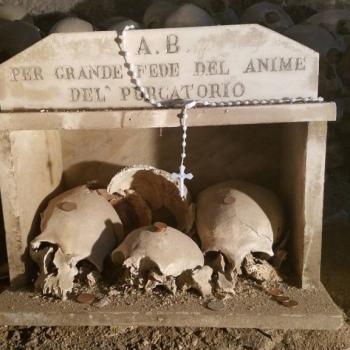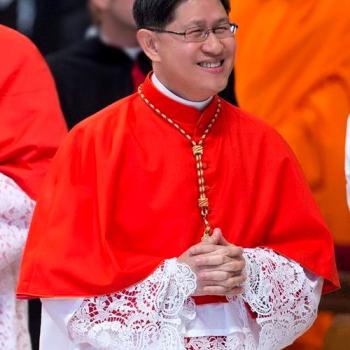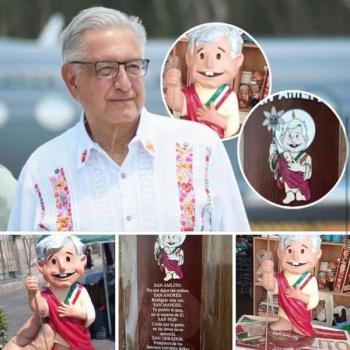By Guest Contributor Dr. Alyssa Maldonado-Estrada*
Nola, a small town outside of Naples in the Campania region of Southern Italy, and Williamsburg, the premiere trendiest neighborhood in New York, are approximately 4,394 miles apart. Nola with its stone streets and ancient grit, is in the shadow of Vesuvius, while Williamsburg is ultra-gentrified and punctuated by high-rise glass condominiums and the shells of old Brooklyn factories. Still, both are central to Italian-American Catholic practice in Brooklyn. What these places share is intense love for Saint Paulinus (~353-431 AD), more affectionately and colloquially known as San Paolino, the patron saint of Nola. Although Italian-American men in Brooklyn might be separated from Italy by generations, what they share with those in Nola is a feeling of devotion in their bodies and in their bones. To love San Paolino is to reenact his hagiography each year, through costuming, ritual and devotional play. While public discussion about the feast in his honor centers on a dying or threatened tradition, there is a larger story here about an enduring devotion among men.
Every summer in Brooklyn, since 1903, hundreds of men gather to lift the giglio, a four-ton, seven-story devotional tower in honor of Paulinus. In Nola, eight gigli, each correlating to a trade guild, dance for twenty four hours—in what was recently named a UNESCO heritage site. When Nola was invaded in the fifth century by the Vandals and its people enslaved, Paulinus gave himself in exchange for a widow’s son and was taken as a slave. He never revealed his identity as a bishop, and worked diligently as a gardener. When the king discovered Paulinus’ true identity, he was so moved by his sacrifice that he allowed him to sail back to Nola with the people from Campania. Upon arrival, the people of Nola greeted Paulinus’ ship with towers of lilies; lily is giglio in Italian. While scholars have disputed who exactly the invaders were, and whether the historical Saint Paulinus was alive at the time of the invasion, devotion to him is vital in Williamsburg.
While observers are interested in what is dying in Williamsburg—Catholic parishes shuttering, hyper-gentrification threatening what is left of old architecture and ethnic communities—devotion is very much still alive; not as a relic of the past, but a central part of the lives of young Catholic men. During the recent assembly of the United States Conference of Catholic Bishops, bishops were troubled about millennial Catholics, arguing that the traditional models of parish are not attracting and retaining an increasingly mobile population. As bishops wring their hands over the “50% of Catholics 30 years old and younger [that] have left the church,” citing troubling statistics like “one out of six millennials in the U.S. is now a former Catholic,” millennial men in Brooklyn continue to be committed in their devotion to the saints. Both the virtual and the ritual are central to their Catholicism. Some of these men live-stream mass; they visit Facebook pages celebrating “All Things Giglio.” Youtube videos allow New York men to virtually visit Nola, learn its traditions, know its ritual environments, and form the global body of the feast. But the local still matters. Whether they live near the parish or not, they routinely return to plan the feast and build its structures.
The dancing of baroque structures entwines devotion with revelry. Since at least the 18th century in Nola and since 1958 in Brooklyn, a boat is also danced with the giglio, completing the hagiographic spectacle. Riding atop the boat is man endowed with the honor of playing the Turk, a turbaned, orientalist caricature in harem pants. He wields a sword, swashbuckling, and sailing over the crowd to meet the giglio, as a statue of San Paolino rides behind him. In Brooklyn, the Turk, played by an man selected for his commitment to serving the parish, is accompanied by little boys who play sailors. Histories of encounter, orientalist imaginings, and collective memory of Southern Italy’s enemies are compressed and overlaid in the drama of the Dance of the Giglio. It is in this embodiment of a racial and religious other that men have the freedom and the opportunity to partake in dramatic display and play with traditionally masculine aesthetics. Lamé, taffeta, rhinestones, and gold galore are all part of playing the Turk. If the lifters are penitential and disciplined, the Turk is their aesthetically excessive foil. In dressing up as the Turk, growing beards, donning turbans, and wielding the sword, men enter a masculine lineage and learn local and legendary history through their bodies.
These highly engaged young men once dressed up as Saint Paulinus in Sunday school plays, they watched the giglio from their front yards and windows, and dreamed of being part of the community since they were boys. This devotion is about much more than muscle. A lifetime of dedication and labor, invisible to the public gaze, is central to being an active member of this community. Lifters and feast organizers are made from little boys shaped in this tradition, ushered into it through costumes, play, and networks of kin and friendship.
One of those young men told me: “I pray to San Paolin, actually my confirmation name is Paolino. So I do have a big devotion to San Paolin.” In the characteristic New York Italian-American style, he dropped the vowel at the end of Paolino: San Paolin. His story is like that of many men, whose love for the saints and the church started early. When he was a little boy of only four years old, he left Brooklyn for the first time and traveled to Nola. As he fell asleep one night he saw two wooden towers out his window. The next morning, he saw another set of towers floating down the street. Poetically, it happened to be just as the sun was rising. The gigli put him to sleep and they woke him up at daybreak. When he was older, at nine years old, he was chosen to play a sailor in Brooklyn. He put on shiny harem pants that ballooned out at his ankles, a matching gold vest, and a thick fake mustache. Instead of sailing on the Mediterranean, he rode on a ship hoisted high above the streets of Williamsburg. He sailed through the crowds and past his parish on the shoulders of lifters, reenacting Paulinus’ journey. He threw confetti, waved a plastic sword, danced to the music of the brass band, and came to know San Paolino through playing a scene from his saintly life, but also through the materiality of that performance. In his twenties, he received the honor of being named Turk. He dressed extravagantly for the part, in gold and jewels, as he entered the lineage of the feast.
“Brooklyn is the heart, Nola is the soul” is a slogan that has become increasingly popular in Brooklyn. Young men have been traveling together to Nola, and in 2017, I was there with them. Speaking shoddy Italian, if any, or mediating conversation through the Google Translate app, the men from Brooklyn speak the same body language as the lifters from Nola. Their nascent fluency is practiced as they get to lift under the wooden poles, as they learn how to rock their bodies back and forth to turn, to take baby steps through precariously narrow streets, to make the giglio move through a town it has been moving through for at least five hundred years. That fluency is honed through listening, through learning exactly what note of a song to lock their knees and square their shoulders to collectively lift the giglio off the ground. To become a part of the paranza (group of lifters) in Nola, men from Brooklyn, in the absence of actual language, share techniques of the body. Emerging from a successful lift in the natal home of the giglio, I’ve seen men cry through dark glasses, hug each other, jump, dance, celebrate together, giddy with joy, intermingling their sweat below the unbearable Campania sun. Whether in Brooklyn or in Nola, these men share a devotion they know with their bones, feet, shoulders, and costumed bodies.
Dr. Alyssa Maldonado-Estrada is Assistant Professor of Religion at Kalamazoo College, and received her PhD from Princeton University. She is an ethnographer specializing in Religion in the Americas, with a focus on masculinity, Catholicism, material culture, and urban religion. She has written on Catholic devotion in the Americas, and her forthcoming book, Lifeblood of the Parish: Men and Catholic Practice in Williamsburg, Brooklyn is a study of a contemporary Catholic parish and examines the religious lives of Catholic men and how they construct and perform ideals of manhood and masculinity through devotional ritual. Follow her on Twitter here.













